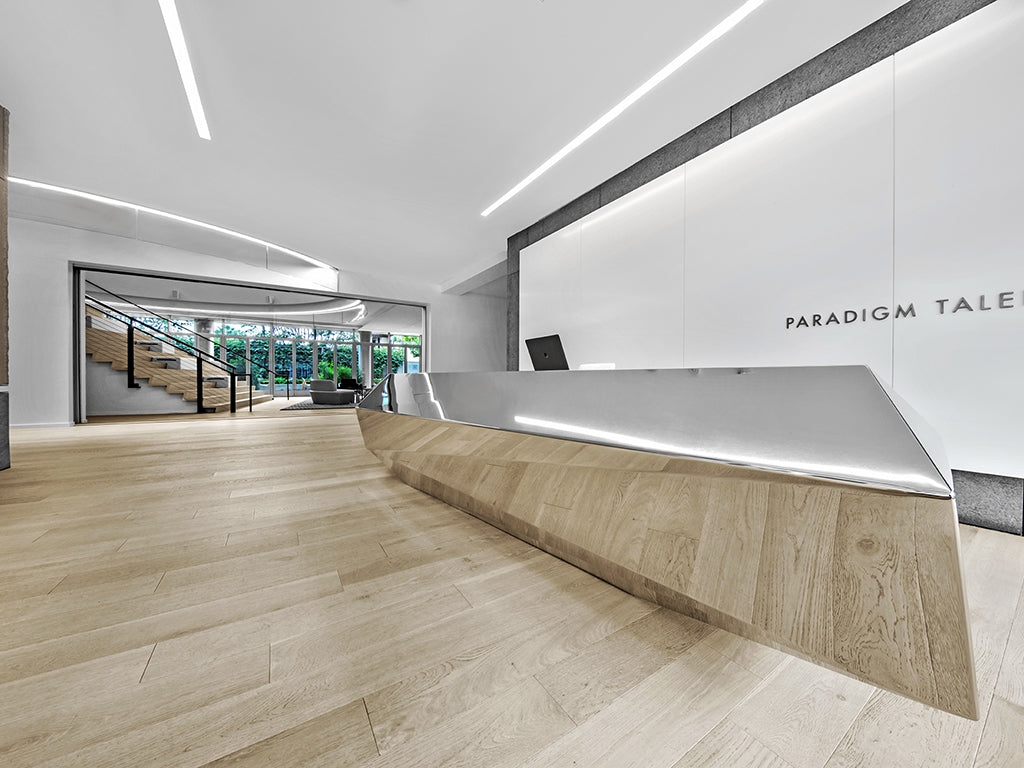Paradigm Talent Agency Beverly Hills Headquarters

Design Firm: Rottet Studio
*Photography and content compliments of Rottet Studio
Year Built: September 2018
Flooring: Monarch Plank Lago Devero
Location: 8942 Wilshire Boulevard, Beverly Hills, California, 90211 USA
Project Overview:
For this 82,000-square-foot project in Beverly Hills, Paradigm Talent Agency challenged the design team to create a space which would foster collaboration, chance encounters and unity across three floors. This project was a full tenant improvement venture within an existing core and shell, and a redesign of the existing courtyard. The build-out consisted of advanced design elements and challenges, including several unique components such as a one-of-a-kind curved interconnecting staircase, screening room, second-floor signing room with curved glass walls, as well as multiple listening rooms and voice over booths. The project’s team members coordinated extensively to execute the project on a condensed schedule and operated with impeccable precision to enable Paradigm to begin serving its impressive roster of clients as quickly as possible.

A principal design goal for this project was to create public meeting areas towards which the staff can gravitate organically and meet during the course of the day. An eye-catching interconnecting staircase, designed to function as a vertical workspace connection between the three levels, features bench seating overlooking the lobby and into the multi-purpose room on the first floor.

Nearby, the large coffee lounge extends from one end through the central courtyard and offers employees and visitors alike a space to work, meet, and socialize. Paradigm Talent Agency reports that this space has encouraged collaboration in a very positive way.

Keeping in mind the heavy foot traffic occurring within a talent agency, Rottet specified European Oak engineered wood flooring (Lago Devero from Monarch Plank) throughout the circulation areas. This flooring choice allowed them to visually tie all three floors together as the wood finish at the first floor extends to the staircase, continuing all the way up to level 3 and blending seamlessly into the wood floors on levels 2 and 3. To ensure a durable finish at the staircase, 2” thick wood planks matching the overall wood floor finish were positioned over the steel structure of the stair.

One of the biggest challenges during the construction of this project was the soaring 3-story staircase which connects all floors and acts as a central vein for movement within the project. The staircase’s layout was completed on the first floor, then using working points transferred to the second and third floors. The third floor portion of the staircase presented the greatest challenge. As part of the design, it had an offset radius making it difficult to lay out. The staircase had to be laid out in an area where the concrete slab no longer existed due to the circular cut out.

Construction of the entire staircase required close coordination and collaboration among the design team and other project teams to ensure that work on the feature was completed precisely and on schedule. For example, the design team and general contractor worked intimately with the scaffolding company to make a scaffold on each floor that was higher than the staircase’s railing by two inches.






